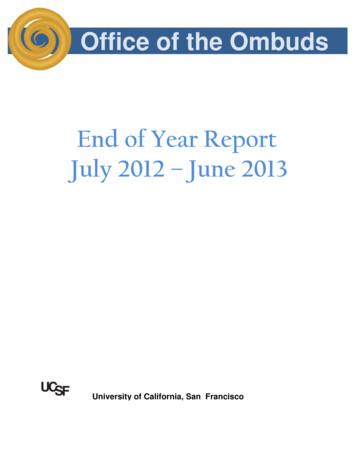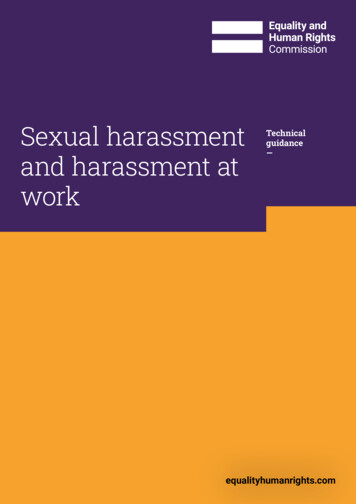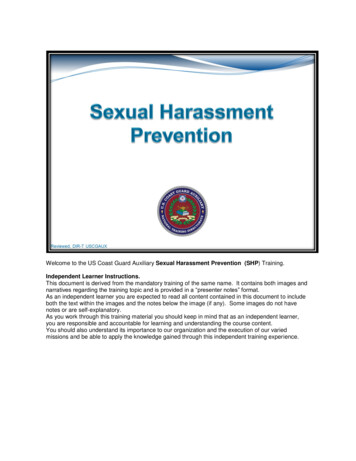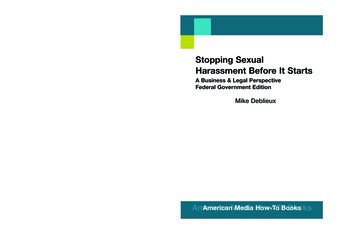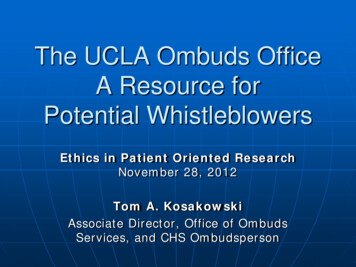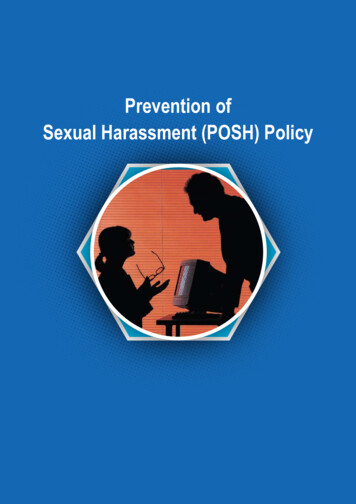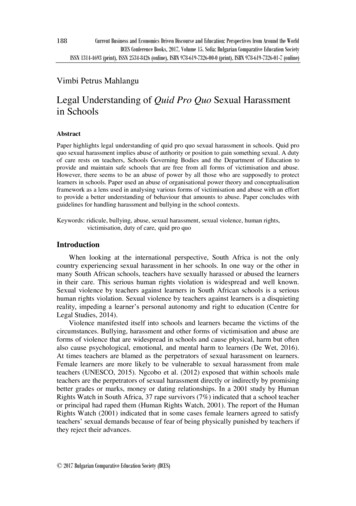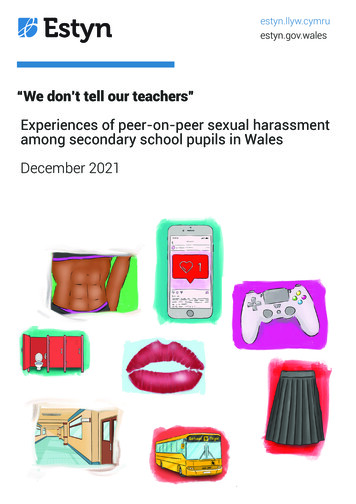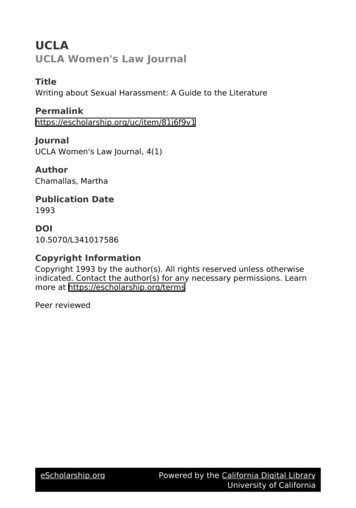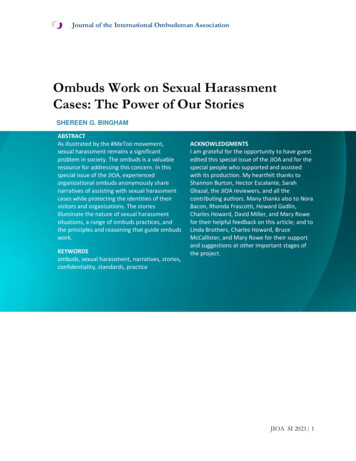
Transcription
Journal of the International Ombudsman AssociationOmbuds Work on Sexual HarassmentCases: The Power of Our StoriesSHEREEN G. BINGHAMABSTRACTAs illustrated by the #MeToo movement,sexual harassment remains a significantproblem in society. The ombuds is a valuableresource for addressing this concern. In thisspecial issue of the JIOA, experiencedorganizational ombuds anonymously sharenarratives of assisting with sexual harassmentcases while protecting the identities of theirvisitors and organizations. The storiesilluminate the nature of sexual harassmentsituations, a range of ombuds practices, andthe principles and reasoning that guide ombudswork.KEYWORDSombuds, sexual harassment, narratives, stories,confidentiality, standards, practiceACKNOWLEDGMENTSI am grateful for the opportunity to have guestedited this special issue of the JIOA and for thespecial people who supported and assistedwith its production. My heartfelt thanks toShannon Burton, Hector Escalante, SarahGhazal, the JIOA reviewers, and all thecontributing authors. Many thanks also to NoraBacon, Rhonda Frascotti, Howard Gadlin,Charles Howard, David Miller, and Mary Rowefor their helpful feedback on this article; and toLinda Brothers, Charles Howard, BruceMcCallister, and Mary Rowe for their supportand suggestions at other important stages ofthe project.JIOA SI 2021 1
Journal of the International Ombudsman AssociationBinghamThe #MeToo movement has made the public aware of a reality that ombuds know all too well:Sexual harassment is a pervasive problem, one that occurs throughout the United States and inevery country of the world. Steeped in inequitable power relations, the problem has long defiedefforts to prevent it (Clair et al., 2019; Senthilingam, 2017). Nearly two thirds of the world’seconomies have legal protections against it, and a range of approaches to diminishing it, such aspolicies, grievance procedures, trainings, and social media campaigns, are in use around theglobe (Cobb, 2014; Kurian, 2019; World Bank Group, 2018). Yet the problem persists, impairingpeople’s psychological and physical health, fulfillment, productivity, and the organizations inwhich we work and learn (McDonald, 2012).Within the ombuds profession, and increasingly beyond it, we know organizational ombuds canbe a useful resource for assisting people with sexual harassment concerns. Many dedicatedprofessionals have devoted their expertise and creativity to bring the ombuds role in sexualharassment cases into the light. They have provided legal analysis, research studies, articles,videos, webinars, tool kits, social media posts, conference presentations, and more. TheInternational Ombudsman Association (IOA) and related professional associations, as well ascommentators and researchers, have repeatedly explained how and why visiting the OmbudsOffice is an appropriate option for people grappling with sexual harassment situations (e.g.,Dobbin & Kalev, 2020; Howard, 2020; IOA, 2020; Rowe,1996, 1990). This is particularly the casewhen ombuds adhere to the IOA Standards of Practice, based in principles of confidentiality,informality, neutrality, and independence (Berman, 2016; Pappas, 2016).However, the value of the organizational ombuds in addressing sexual harassment is stillunderrecognized. That’s partly because ombuds’ interactions with their visitors are confidential,off-the-record, and outside an organization’s formal investigatory and grievance processes, as theIOA standards require. Remaining confidential, while essential to the ombuds role andeffectiveness, complicates the task of raising awareness and understanding of both ombudspractices and the value they bring to organizations. Professionals who view sexual harassmentand its remedies through a narrow legal or policy perspective of mandatory reporting andinvestigation have sometimes misunderstood, disregarded, or undervalued ombuds work. Theyhave not grasped, for example, that ombuds can have an important role in creating the conditionsthat enable those who have been sexually harassed to come forward with formal complaints.Ombuds need as many ways as possible to publicly share what they do and why their work isuseful in specific circumstances, while simultaneously protecting the identities and confidentialityof their visitors and organizations. This special issue of the JIOA helps to address these needs.In this special issue, anonymous organizational ombuds share stories of their experiencesworking with visitors on sexual harassment cases and candidly reflect on their practices. Theauthors’ narratives are educational, thought-provoking, and often intense; they reveal andparticularize the role, challenges, and value of the organizational ombuds in responding to sexualharassment. The collection of stories not only shines light on sexual harassment situations; itilluminates a range of methods for addressing them. It also illustrates principles and reasoningthat guide ombuds practices and shares lessons learned. The goal of this forum is to elevateunderstanding, reflection, and lively discussion about the nature of ombuds work both within andoutside the profession.Twelve experienced ombuds submitted stories for the forum and all twelve stories have beenpublished here. The authors are a diverse group in terms of gender, age, ethnicity, and location inthe world. These authors are all intentionally anonymous. They have altered or omitted namesand other nonessential details as needed to protect the identities of their visitors, organizations,and other parties. Consequently, the authors are receiving no public recognition for publishingtheir stories. The individual authors and I are the only ones who know their identities, and Irecognize this as both a privilege and responsibility. The ombuds who contributed stories are dueJIOA SI 2021 2
Journal of the International Ombudsman AssociationBinghamour wholehearted thanks and appreciation. Without their generosity and expertise, there would beno special issue at all.The twelve narratives do not, of course, describe all the possible approaches and methodsombuds may use when responding to sexual harassment. For example, the stories do notdescribe use of mediation (Gadlin, 1991) or the “generic approach” (Rowe, 2021). Nor do theyrepresent the whole range of sexual harassment situations that are brought to ombuds forassistance. However, by focusing on one important type of problem – sexual harassment –through the lens of twelve different experiences, the stories provide contextualized, multi angled,deep understanding of ombuds’ responses to sexual harassment cases. A partial list of questionsand issues addressed in the narratives includes: Why is ombuds confidentiality essential in sexual harassment cases? How is it differentfrom allowing harassment to be “swept under the rug”? How do ombuds help visitors and bystanders who are uncertain or fearful about making aformal report? How do ombuds assist when visitors want to stop the harasser without notifying theirorganization? Why is ombuds neutrality important in sexual harassment cases? How does the ombudsexpress it? How do ombuds prevent their own emotions and biases from negatively influencing theirwork in sexual harassment cases? What can ombuds do to assist an alleged perpetrator of sexual harassment? How can ombuds help when different cultural understandings may be fueling theharassment? How do ombuds work with bystanders in sexual harassment cases? What can ombuds do to help the organization prevent “serial” harassers (who harassmultiple people) and department cultures that foster sexual harassment? What is the impact on the ombuds of working with sexual harassment cases? If an organization’s sexual harassment policy and procedures are inadequate or unfairlyapplied, how can an ombuds help?This special issue arose in the context of narrative theory, research, and practice (e.g., Clair, etal., 1996; Muir & Mangus, 1994; Wood, 1992). Appreciation for the power of narratives to givevoice to experiences, especially of marginalized individuals and groups, has flourished in recentdecades, and especially in the wake of #MeToo. Publications, broadcasts, social media, andother forums have enabled victims and survivors of sexual harassment to publicly share theirexperiences, educating their communities about the nature of the problem. One such forum was aspecial issue of The Journal of Applied Communication Research (JACR), published in 1992.Predating #MeToo’s recent surge in social media by over twenty-five years, JACR published acollection of communication academics’ own sexual harassment experiences, demonstratingnarrative’s capacity to empower survivors and let their voices be heard (Eddie, 1992; “Ourstories,” 1992; Wood, 1992). That innovative publication in the field of communication was amodel for this issue of the JIOA.Many professions have published survey results, interviews, and stories of sexual harassmentexperiences written by victims and survivors within their own fields. In contrast, the focus of thisspecial issue is not on ombuds’ own experiences with being sexually harassed. However, thatfocus is not meant to imply that we should complacently assume the ombuds profession is aharassment-free zone. Like other professionals, ombuds may be victims or harassers in their ownworkplaces as well as at ombuds conferences and training events (Adams & Rasch, 2020). Infact, the Call for Papers for this issue drew inquiries from two ombuds who were each interestedin submitting their own stories as survivors of sexual harassment on the job. As Adams andJIOA SI 2021 3
Journal of the International Ombudsman AssociationBinghamRasch advise, it is incumbent upon the ombuds profession to look thoroughly inward andestablish exemplary sexual harassment policies, practices, and methods for reporting andreceiving support.While our forum is not designed to give voice to sexual harassment survivors, the authors’ storiesmay be empowering in different ways. In the context of this anonymous forum, the authors wereable to publicly share, perhaps for the first time, their own detailed stories of assisting in sexualharassment cases. These narratives are lived experiences that demonstrate the ombuds’expertise and ingenuity. However, these are not glossy, frictionless case studies with always tidyendings, intended to make the ombuds appear flawless and unflappable. To the contrary, thestories reveal the ombuds’ human emotions, uncertainties, and internal struggles as they helpvisitors navigate the complexities, risks, and enigmas that often arise in sexual harassmentcases.The narratives also reveal how ombuds can empower people who are struggling with sexualharassment situations. Responding as an individual to sexual harassment can be fraught withfears, uncertainty, and stress. Power inequities and organizational cultures that tolerate sexualharassment make responding especially dangerous and complex for people whose status andpower in the organization are low (Bingham, 1991; Bingham & Battey, 2005). Many organizationsare not perceived as safe or trustworthy places for people to speak openly or publicly about theirconcerns. And despite an organization’s intentions to be fair to all parties, many internalimpediments dissuade people from seeking and receiving assistance (Rowe, Wilcox, & Gadlin,2009).However, ombuds offices serve to eliminate the barriers that deter people from seeking help byoffering a context where it is safe to come forward (Rowe & Bendersky, 2002). By guaranteeing aconfidential, off-the-record environment, ombuds provide a place for their visitors to talk aboutsexual harassment experiences without fearing they will forfeit privacy, lose control over actionstaken on their behalf, or suffer retaliation. Ombuds can also help visitors understand the availableorganizational resources that obligate a harasser to cease harassment. Direct communicationwith a harasser may be more effective when organizations have clear policies, procedures, andconsequences for wrongdoing that individuals know about and can readily utilize (Bingham &Burleson, 1989; Bingham & Scherer, 1993).Ombuds follow the IOA Standards of Practice with all their visitors, whether they are victims orsurvivors, harassers, alleged harassers, or other parties. Bystanders, for example, may makereferrals to the ombuds office, accompany a victim there, or visit with the ombuds on their own(Rowe, 2018, 2020). Because ombuds may work with parties in all these roles, ombuds develop aperspective from which they can better understand individual experiences. Regardless of theirroles or circumstances, an ombuds listens to people, helps them analyze their situations andreactions, supports them in thinking through the available options and implications, and providesspace for them to express feelings and make decisions about what to do.Our collection of narratives may also be empowering to ombuds as a result of the authors’engagement in reflective practice. Reflective practice is a learning experience that professionalsin a variety of fields use to increase their knowledge, skills, and quality of work. Lang (2019), forexample, offers a guide to reflective practice for dispute resolution professionals that involvessystematic reflection, questioning, insight, continuous learning, and improvement. The practicecan occur alone or in reflective practice groups. As the authors in this forum tell their stories, theyreflect on their communication with visitors and other parties and the reasoning behind theiractions, and share significant lessons learned. In turn, this forum provides the opportunity forreaders – new, aspiring, and experienced organizational ombuds and others outside theprofession – to explore the ombuds stories and reap valuable lessons of their own.JIOA SI 2021 4
Journal of the International Ombudsman AssociationBinghamPublication of these narratives is not the end of the story. Part two of the special issue is yet tounfold. The JIOA encourages readers to mull over these narratives, discuss them, critique them,apply what you learn from them and – perhaps most of all – use them as data for your ownresearch. Part two of the special issue will comprise research studies written by ombuds andother researchers who venture to analyze this collection of stories using qualitative or quantitative(content analysis) methods. By identifying and interpreting patterns that emerge across thenarratives, research can further elucidate organizational ombuds work with sexual harassment. Ihope the narratives in this forum will inspire others as much as they have inspired me.It is useful at the conclusion of any project to reflect on how it could be improved. I wish I hadbeen able to persuade more ombuds to submit stories to this forum, including more storiesinvolving male visitors, as well as visitors who experienced sexual harassment at theintersections of sexism, racism, heterosexism, homophobia, and other modes of oppression (e.g.,Biaggio, 1997; Calafell, 2014; Richardson & Taylor, 2009; Robelo & Cortina, 2014; Scarduzio, etal., 2018). Future forums of this kind, whether focused on sexual harassment or another type ofproblem, should include more narratives portraying more diversity and additional approaches toombuds work.JIOA SI 2021 5
Journal of the International Ombudsman AssociationBinghamREFERENCESAdams, C. & Rasch, D. (2020, December 22). Sexual harassment, consensual relationships, andthe ombuds profession. Journal of the International Ombudsman Association, 1-9. Retrievedfrom https://www.ombudsassociation.org/assets/docs/JIOA Articles/2020-JIOA-G-AdamsRasch.pdfBerman, B. M. (2016, March 24). Campus ombuds as confidential resource for purposes of TitleIX and Clery Act reporting. Letter to the Board of Directors of the International OmbudsmanAssociation. Retrieved from er-Hale-memoand-cover-March-2016.pdfBiaggio, M. (1997). Sexual harassment of lesbians in the workplace, Journal of Lesbian Studies,1:3-4, 89-98. https://doi.org/10.1300/J155v01n03 05Bingham, S. G. (1991). Communication strategies for managing sexual harassment inorganizations: Understanding message options and their effects. Journal of AppliedCommunication Research, 19(1-2), 88-115. https://doi.org/10.1080/00909889109365294Bingham, S. G. & Burleson, B. R. (1989). Multiple effects of messages with multiple goals: Someperceived outcomes of responses to sexual harassment. Human Communication Research, 16,184-216. Bingham, S. G. & Battey, K. (2005). Communication of social support to sexual harassmentvictims: Professors’ responses to a student’s narrative of unwanted sexual attention.Communication Studies, 56(2), 131-155. https://doi.org/10.1080/00089570500078767Bingham, S.G., & Scherer, L. L. (1993). Factors associated with responses to sexual harassmentand satisfaction with outcome. Sex Roles: A Journal of Research, 29, 3/4, , N. T. & Ormerod, A. J. (2002). Racialized sexual harassment in the lives of AfricanAmerican women. Women and Therapy 25(3-4) 107-124. https://doi.org/10.1300/J015v25n03 08Calafell, B. M. (2014). Did it happen because of your race or sex? University sexual harassmentpolicies and the move against intersectionality. Frontiers: A Journal of Women Studies, 35(3), 7595. ir, R. P., Brown, N. E., Dougherty, D. S., Delemeester, H. K., Geist-Martin, P., Gorden, W. I.,Sorg, T., & Turner, P. K. (2019). #MeToo, sexual harassment: an article, a forum, and a dreamfor the future. Journal of Applied Communication Research, 47(2), 67142Clair, R. P., Chapman, P. A., & Kunkel, A. W. (1996). Narrative approaches to raisingconsciousness about sexual harassment: From research to pedagogy and back again. Journal ofApplied Communication Research, 24(4), 241-259. https://doi.org/10.1080/00909889609365455Cobb, E. P. (2014, December 3). Sexual harassment law evolving l.aspxJIOA SI 2021 6
Journal of the International Ombudsman AssociationBinghamDobbin, F., & Kalev, A. (2020, May-June). Why sexual harassment programs backfire. HarvardBusiness Review. Retrieved from ramsbackfireEadie, W. F. (1992). Editorial. Journal of Applied Communication Research, 20, v – vi. doi:10.1080/00909889209365342Gadlin, H. (1991). Careful maneuvers: Mediating sexual harassment. Negotiation Journal, 7(2),139–153. https://doi.org/10.1007/BF01000346Howard, C. (2020, May-June). What happens when an employee calls the ombudsman? HarvardBusiness Review, 98(3), 59-60. Retrieved from ee-calls-the-ombudsman?ab seriesnav-spotlightInternational Ombudsman Association (2020, June 23). New studies recommend ombudsprograms for protecting victims of sexual harassment and discrimination [Press release].Retrieved from s Releases/2020-0623 IOA Harassment Reports Press Release.pdfKurian, A. (2019, March). Women’s fight against sexual harassment didn’t start with #MeToo. TheConversation. arassment-didnt-start-metoo/Lang, M. (2019). The guide to reflective practice in conflict resolution. Rowman and Littlefield.McDonald, P. (2012). Workplace sexual harassment 30 years on: A review of the literature.International Journal of Management Reviews, 14(1), 1–17. r J. K., & Mangas, K. (1994). Talk about sexual harassment: Women’s stories on a woman’sstory. In S. G. Bingham (Ed.), Conceptualizing sexual harassment as discursive practice (pp. 91105). Praeger Publishers.“Our stories”: Communication professionals’ narratives of sexual harassment. (1992). Journal ofApplied Communication Research, 20, 363-390. https://doi.org/10.1080/00909889209365344Pappas, B. A. (2016). Out of the shadows: Title IX, university ombuds, and the reporting ofcampus sexual misconduct. Denver Law Review, 94(1), 23/27484335/1489098893930/71 Pappas Out from the Shadows.pdf?token 8T%2Bhc3oyak6EtSEuwyhtCVsivfs%3DRabelo, V. C., & Cortina, L. M. (2014). Two sides of the same coin: Gender harassment andheterosexist harassment in LGBQ work lives. Law and Human Behavior, 38(4), dson, B. K. & Taylor, J. (2009). Sexual harassment at the intersection of race and gender:A theoretical model of the sexual harassment experiences of women of color. Western Journal ofCommunication, 73(3), 248-272. https://doi.org/10.1080/10570310903082065Rowe, M. (2021). Offer generic options when complainants and bystanders are very afraid.[Working paper]. http://mitmgmtfaculty.mit.edu/mrowe/Rowe, M. P. (2020). Supporting bystanders. See something, say something is not enough.[Working paper]. licationDocumentID 6080JIOA SI 2021 7
Journal of the International Ombudsman AssociationBinghamRowe, M. P. (2018). Fostering constructive action by peers and bystanders in organizations andcommunities. Negotiation Journal, 34(2), 137-163. https://doi.org/10.1111/nejo.12221Rowe, M. P. (1996). Dealing with harassment: A systems approach. In M. S. Stockdale (Ed.),Sexual harassment in the workplace: Perspectives, frontiers, and response strategies. (pp. 241–271). Sage Publications, Inc. http://dx.doi.org/10.4135/9781483327280.n12Rowe, M. (1990). People who feel harassed need a complaint system with both formal andinformal options. Negotiation Journal, 6(2), 161-172. owe, M. & Bendersky, C. (2002). Workplace justice, zero tolerance, and zero barriers: Gettingpeople to come forward in conflict management systems. In T. Kochan and R. Locke (Eds),Negotiations and change, from the workplace to society (pp. 117-140). Cornell University Press.Rowe, M., Wilcox, L, & Gadlin, H. (2009). Dealing with – or reporting – “unacceptable” behavior.Journal of the International Ombudsman Association, 2(1), A Articles/JIOA Vol2.pdfScarduzio, J. A., Wehlage, S. J., & Lueken, S. (2018). “It’s like taking your man card away”: Malevictims’ narratives of male-to-male sexual harassment. Communication Quarterly, 66(5), 481–500. 73.2018.1447978Senthilingam, M. (2017). Sexual harassment: How it stands around the globe. Retrieved od, J. T. (1992). Telling our stories: Narratives as a basis for theorizing sexual harassment.Journal of Applied Communication Research, 20, 349 - 362.https://doi.org/10.1080/00909889209365343World Bank Group (2018). Women, business and the law 2018. Washington, DC: World Bank.License: Creative Commons Attribution CC BY 3.0 IGO. Retrieved 86/29498JIOA SI 2021 8
represent the whole range of sexual harassment situations that are brought to ombuds for assistance. However, by focusing on one important type of problem - sexual harassment - through the lens of twelve different experiences, the stories provide contextualized, multi angled, deep understanding of ombuds' responses to sexual harassment cases.
